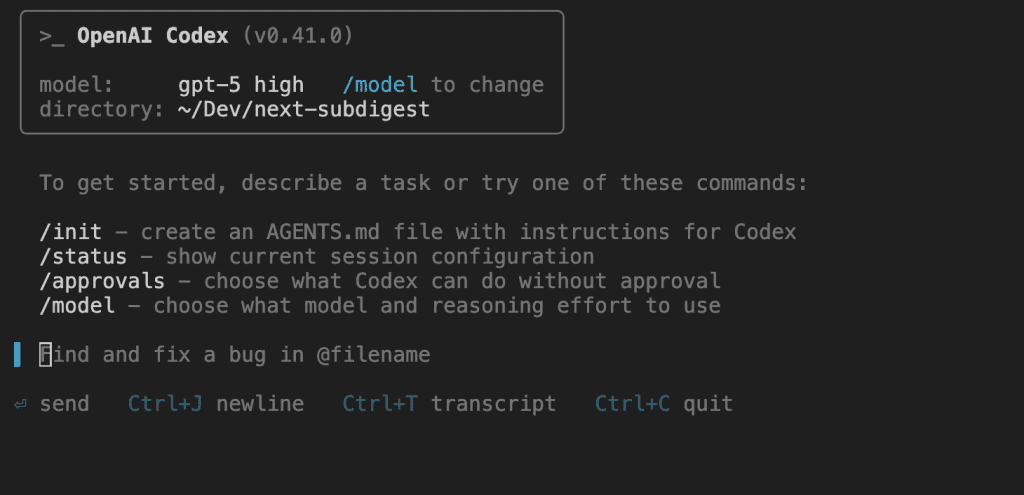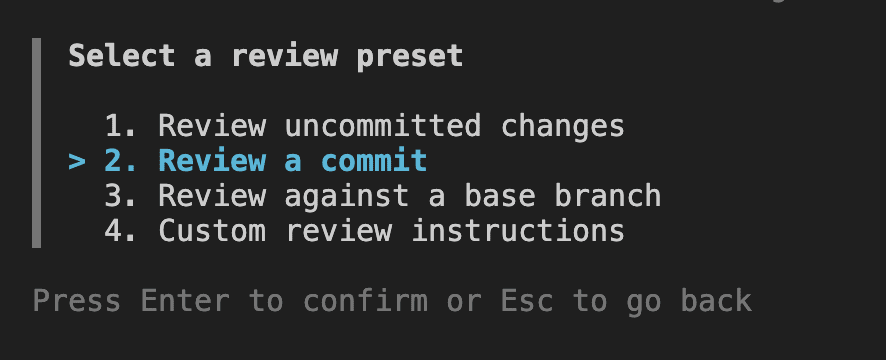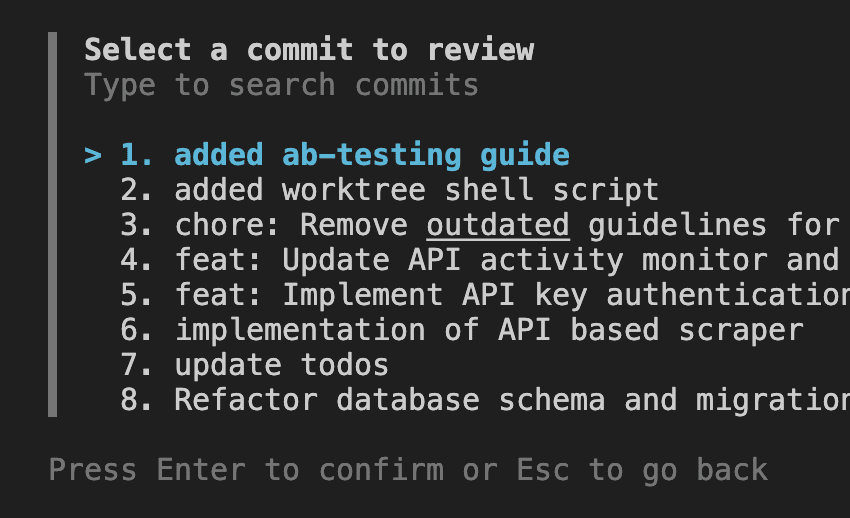The Latest Codex CLI Commands That Will Save Your Sanity (And Your Rate Limits)
You fire up Codex CLI for a quick task.
Five minutes later, you’re rate-limited.
“When can I code again?” you wonder, staring at the unhelpful error message.
Or maybe you’re trying to get structured JSON from exec, but it returns a wall of text instead.
Or you want Code Review feedback, but you’re not sure how to get the most out of /review.
Sound familiar?
Codex CLI v0.41 just shipped with fixes for all of these headaches.

But here’s the thing – most developers don’t even know these features exist.
Let me show you the three commands that will transform how you use Codex CLI, plus the exact fixes for the issues that drive us all crazy.
.
.
.
But First: Are You Even On v0.41?
Most people aren’t.
They’re running older versions and wondering why things don’t work right.
Check your version right now:
codex --version
codex-cli 0.41.0Not on 0.41? Here’s the fastest way to update:
If you use npm:
npm install -g @openai/codex@latest
If you use Homebrew:
brew update && brew upgrade codex
30 seconds. That’s all it takes.
Now let’s dive into the commands that actually matter.
The /status Command: Finally See Your Usage BEFORE You Hit The Wall
Here’s what drives me crazy.
You’re coding. Everything’s flowing. Then BAM – rate limit exceeded.
No warning. No heads up. Just sudden death to your productivity.
The worst part? You had no idea you were even close to the limit.
Before v0.41, you were flying blind. Now, /status shows you exactly how much runway you have left.
.
.
.
The Game-Changing Update Nobody’s Talking About
v0.41 added usage tracking to /status.
Look at this beauty:
codex /status

See those percentages?
- 10% used on your 5-hour limit
- 15% used on your weekly limit
- Exact reset times for both
Now you can actually plan.
Big task coming up? Check your usage first. Running low? Save it for after the reset.
No more surprises.
.
.
.
The Blank Usage Bug (And The 2-Second Fix)
But wait. You run /status and the usage section is… empty?

This happens to everyone. Here’s the stupidly simple fix:
# Send a throwaway message first codex > hi > /status


Why does this work?
Usage data loads after your first message. It’s a known bug. Now you know the workaround.
.
.
.
How to Never Get Surprised Again
Make checking /status a habit:
# Add to your shell profile alias cs="codex /status" # Quick check # Before starting big tasks cs # Am I good to go?
When you see you’re at 80% on your 5-hour limit, you know it’s time to wrap up or switch to lighter tasks.
When you see you’re at 90% on your weekly limit on a Wednesday, you know to save heavy lifting for next week’s reset.
The power isn’t just seeing the limits. It’s planning around them.
.
.
.
Want techniques like these weekly?
Join The Art of Vibe Coding—short, practical emails on shipping with AI (without the chaos).
No spam. Unsubscribe anytime. Seriously.
The /review Command: Your AI Code Reviewer That Actually Works
You just finished a feature.
Before committing, you want a second pair of eyes on it.
But your teammate is busy. Or it’s 2 AM. Or you just want a sanity check before the PR.
Enter /review – the command that turns Codex into your always-available Code Reviewer.
.
.
.
### The Interactive Menu (The Feature Most People Miss)
Here’s what blew my mind when I discovered it.
Just type `/review` with no arguments:
“`bash
codex /review
“`
And you get this beautiful interactive menu:

Pick option 2, and watch this magic:

You can:
– Search commits by typing – Just start typing to filter
– Navigate with arrow keys – Up/down through your commit history
– Hit Enter to review – Instant analysis begins

Why this changes everything:
No memorizing commit hashes. No complex git commands. Just browse, select, review.
It’s like having a git GUI built into your terminal.
.
.
.
Three Ways to Review (From Basic to Brilliant)
1. Review Your Staged Changes
The basics. Stage what you want reviewed:
git add -p # Stage specific chunks codex /review
2. Review a Specific Commit
Made a commit but having second thoughts?
# Review the last commit codex /review commit HEAD # Review any commit codex /review commit abc123def
3. The Power Move: Custom Instructions
This is where /review becomes magical:
# Security-focused review codex /review diff --base main --instructions "Check for SQL injection, XSS, and auth bypasses" # Performance review codex /review diff --base main --instructions "Find N+1 queries and unnecessary database calls" # API contract review codex /review diff --base main --instructions "Verify backward compatibility and semantic versioning"
.
.
.
GitHub PR Reviews (The Feature Nobody Uses)
Did you know Codex can review PRs directly on GitHub?
Just comment on any PR:
@codex review for memory leaks
Setup required: Enable Code Review for your repo first. Takes 2 minutes.
.
.
.
The Selective Staging Trick
Here’s a pro move most developers miss:
Don’t review everything. Review what matters.
# Stage only the business logic git add -p src/core/ # Skip the test files and configs # Now review JUST the important stuff codex /review
Why this matters:
- Focused reviews catch more issues
- Less noise, better signal
- Faster reviews, clearer feedback
Stage surgically. Review intelligently.
.
.
.
The exec Command: Finally, JSON That Doesn’t Suck
You need Codex to analyze something and return JSON.
So you run:
codex exec "analyze the codebase and return findings as JSON"
What you get back?
A wall of text with some JSON-ish stuff buried in the middle. Good luck parsing that in your CI pipeline.
v0.41 fixed this nightmare.
.
.
.
The Schema Revolution
Here’s the game-changer: --output-schema
You tell Codex EXACTLY what JSON structure you want. It delivers exactly that.
Watch this magic:
# 1. Create your schema (analysis-schema.json)
{
"type": "object",
"properties": {
"summary": { "type": "string" },
"issues": {
"type": "array",
"items": {
"type": "object",
"properties": {
"severity": {
"type": "string",
"enum": ["low", "medium", "high", "critical"]
},
"file": { "type": "string" },
"description": { "type": "string" }
}
}
}
},
"required": ["summary", "issues"]
}
# 2. Run with schema enforcement
codex exec --output-schema analysis-schema.json
"Find security issues in the codebase"
# 3. Get PERFECT JSON every time
The result?
Parseable. Predictable. Production-ready JSON.
Every. Single. Time.
.
.
.
See What Codex Is Thinking
Ever wonder what Codex is planning before it executes?
The new --include-plan-tool flag shows you:
codex exec --include-plan-tool "Refactor the auth module for better testing"
Why this matters:
- Debug long-running commands
- Understand Codex’s approach
- Catch issues before execution
- Learn from its planning process
.
.
.
The Model Bug You Need to Know
Warning: There’s a fresh bug where --output-schema gets ignored with gpt-5-codex.
The workaround? Use gpt-5 instead:
# Doesn't respect schema (bug) codex config set model gpt-5-codex codex exec --output-schema schema.json "task" # Returns unstructured text # Works perfectly codex config set model gpt-5 codex exec --output-schema schema.json "task" # Returns proper JSON
The team knows. Fix coming soon. For now, use gpt-5 when you need schemas.
.
.
.
The Hidden Gem: No More Ripgrep Errors
Remember those annoying postinstall errors?
Error: ripgrep binary not found Please install ripgrep manually
v0.41 bundles ripgrep. No more install failures in CI. It just works.
Small fix. Huge relief.
.
.
.
Your Cheat Sheet (Copy This)
# Version check codex --version # Are you on 0.41? # Status & rate limits codex /status # See limits & reset times # Review commands codex /review # Review staged changes codex /review commit HEAD # Review last commit codex /review diff --base main --instructions "focus on X" # Custom focused review # Exec with structure codex exec --output-schema schema.json "task" # Get JSON back codex exec --include-plan-tool "task" # See the planning
.
.
.
Your Action Items
- Update to v0.41 right now (seriously, it takes 30 seconds)
- Add rate limit checks to your shell profile:
alias cs="codex /status" # Quick status check - Create JSON schemas for your common exec tasks
- Set up
/reviewin your git hooks:# In .git/hooks/pre-commit codex /review || exit 1 - Switch models if you hit bugs (gpt-5 vs gpt-5-codex)
.
.
.
The Bottom Line
Codex CLI v0.41 isn’t just an incremental update.
It’s the difference between guessing and knowing.
Between random failures and predictable workflows.
Between text soup and structured data.
These three commands – /status, /review, and exec – aren’t just features. They’re workflow transformers that turn Codex from a cool tool into an essential part of your development process.
The tools are ready. The bugs have workarounds. The productivity gains are real.
What will you build now that your tools actually work?
P.S. – I discovered the usage tracking feature after hitting rate limits three times in one day. Now I check /status before starting any big task. Haven’t been surprised by a rate limit since.
P.P.S. – Yes, the model-specific bugs are annoying. But switching models takes 2 seconds, and the productivity gains are worth the minor inconvenience. The team ships fixes fast – check the GitHub issues for updates.
Leave a Comment